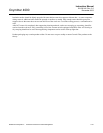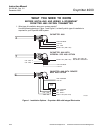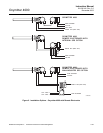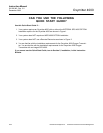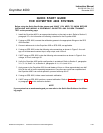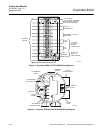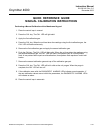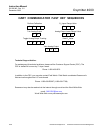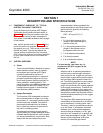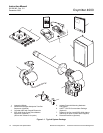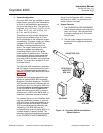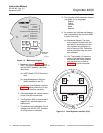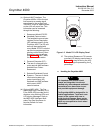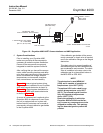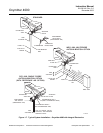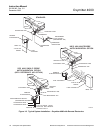
Instruction Manual
IB-106-340 Rev. 3.0
December 2003
Rosemount Analytical Inc. A Division of Emerson Process Management Description and Specifications 1-1
Oxymitter 4000
SECTION 1
DESCRIPTION AND SPECIFICATIONS
1-1 COMPONENT CHECKLIST OF TYPICAL
SYSTEM (PACKAGE CONTENTS)
A typical Rosemount Oxymitter 4000 Oxygen
Transmitter should contain the items shown in
Figure 1-1. Record the part number, serial num-
ber, and order number for each component of
your system in the table located on the first page
of this manual.
Also, use the product matrix in Table 1-1 at the
end of this section to compare your order num-
ber against your unit. The first part of the matrix
defines the model. The last part defines the
various options and features of the Oxymitter
4000. Ensure the features and options specified
by your order number are on or included with
the unit.
1-2 SYSTEM OVERVIEW
a. Scope
This Instruction Bulletin is designed to supply
details needed to install, start up, operate,
and maintain the Oxymitter 4000. Signal
conditioning electronics outputs a 4-
20 mA signal representing an O
2
value and
provides a membrane keypad or fully func-
tional Local Operator Interface (optional) for
setup, calibration, and diagnostics. This
same information, plus additional details, can
be accessed with the HART Model 275/375
handheld communicator or Asset Manage-
ment Solutions (AMS) software.
b. System Description
The Oxymitter 4000 is designed to measure
the net concentration of oxygen in an indus-
trial process; i.e., the oxygen remaining after
all fuels have been oxidized. The probe is
permanently positioned within an exhaust
duct or stack and performs its task without
the use of a sampling system.
The equipment measures oxygen percent-
age by reading the voltage developed across
a heated electrochemical cell, which consists
of a small yttria-stabilized, zirconia disc. Both
sides of the disc are coated with porous
metal electrodes. When operated at the
proper temperature, the millivolt output volt-
age of the cell is given by the following
Nernst equation:
EMF = KT log
10
(P
1
/P
2
) + C
Where:
1. P
2
is the partial pressure of the
oxygen in the measured gas on
one side of the cell.
2. P
1
is the partial pressure of the
oxygen in the reference air on
the opposite side of the cell.
3. T is the absolute temperature.
4. C is the cell constant.
5. K is an arithmetic constant.
NOTE
For best results, use clean, dry, in-
strument air (20.95% oxygen) as the
reference air.
When the cell is at operating temperature
and there are unequal oxygen concentra-
tions across the cell, oxygen ions will travel
from the high oxygen partial pressure side to
the low oxygen partial pressure side of the
cell. The resulting logarithmic output voltage
is approximately 50 mV per decade. The
output is proportional to the inverse logarithm
of the oxygen concentration. Therefore, the
output signal increases as the oxygen con-
centration of the sample gas decreases. This
characteristic enables the Oxymitter 4000 to
provide exceptional sensitivity at low oxygen
concentrations.
The Oxymitter 4000 measures net oxygen
concentration in the presence of all the prod-
ucts of combustion, including water vapor.
Therefore, it may be considered an analysis
on a “wet” basis. In comparison with older
methods, such as the portable apparatus,
which provides an analysis on a “dry” gas
basis, the “wet” analysis will, in general, indi-
cate a lower percentage of oxygen. The dif-
ference will be proportional to the water
content of the sampled gas stream.



